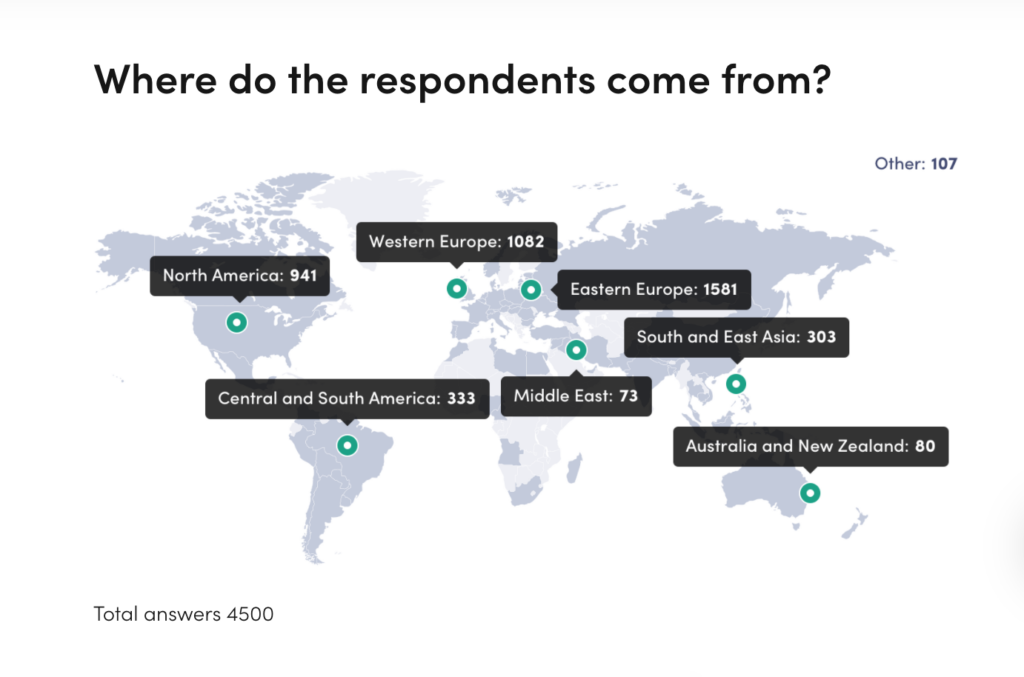One of the points of the mission statement of SoDA is industry thought leadership defined as publishing our research and promoting valuable publications of our member companies. In the recent weeks The Software House has published “The State of Frontend 2020” report — based on 4,500 surveys filled by developers worldwide and 1,000+ downloads in the first week.
Questions: Łukasz Czajkowski, SoDa
Answers: Marek Gajda, Chief Technology Officer and co-founder of The Software House, the highest-rated software development company from Poland in 2020 according to Clutch.
How did you manage to conduct a survey throughout that many developers from all over the world?
We have shared our knowledge and experience with the software development community for years. We regularly publish articles on software development and we offer insightful commentaries on conducting business in the IT sector. This year, we’ve already compiled and published the report on microservices which are more and more popular these days but still controversial. Thanks to all of that, we’ve managed to build a network that willingly responds to our invitations and takes part in our research projects. Our State of Frontend survey was mostly promoted among development communities and in a large group of our business partners. It helped to conduct a successful survey with 4500 responses from the specialists coming from all over the world and to get some insightful comments from reputable experts such as Guillermo Rauch (CEO at Vercel), Luca Mezzalira (VP of Architecture at DAZN), Jessica Jordan (Developer Advocate at .cult) or Tim Netukens (Head of Next.js at Vercel).
What we can learn from this frontend development report?
It’s an overview of the trends, innovations, the best solutions, and tools — the knowledge compendium for frontend developers and CTOs. It can help them evaluate and develop strategies for frontend development. You don’t have to look far. A few years ago, such solutions as Continuous Integration were reserved for the backend. However, frontend developers understood that they could use it too. Now, as many as 77% of the respondents declare to use CI. Also, almost ⅓ of developers built a Jamstack website recently, and most probably it will become more and more popular in the following months (and, speaking of changes: we now write “Jamstack” rather than “JAMstack”).
What are the most important conclusions that can be drawn from this report?
I knew that React was the most popular framework, however, I didn’t expect more developers to use it than Angular and Vue.js combined. It’s a clear forecast that React will still reign supreme in the nearest future. Many developers indicated that they want to learn Vue.js and Svelte. It can be seen as a sign of Angular’s twilight.
The results regarding hosting are pretty interesting too. Developers use everything they can find on the market. From DCs (data centers), through a variety of cloud service providers, to completely new solutions such as Netlify or Vercel. At the same time, AWS is strengthening its position among cloud solutions. According to the report, more developers use AWS (38.7%) than Google Cloud Platform (14.2%) and Microsoft Azure (11.5%) combined.
What’s the most surprising finding?
It’s pretty shocking how thin is the line between love and hate among frontend developers. For example, React + Redux stack, which was so popular recently, seems to become a thing of the past. As many as 34% of respondents think that Redux would virtually disappear within the next 3 years.
Do you plan to compile any other reports of this kind in the future?
For sure. We just need to decide on a subject as it’s certainly a bottomless pit. Software development evolves really quickly. Looking at the momentum with which new technologies are entering the reality around us and how they change our world, I predict that this pace will only increase. That’s why I believe that any initiatives that can organize and constitute a source of knowledge in this area are necessary.
The State of Frontend report showed not only what the situation in terms of solutions or tools is, but also how developers work. As many as 92% of the respondents declared to be part of a bigger development team over the course of last year. Interestingly, QA specialists, i.e. software testers, were absent from such teams in more than 50% of cases. This is important information for CTOs who want to know how to build and manage development teams in the face of rapidly changing software development processes and tools.
Therefore, perhaps the report shedding light on human resources in IT is another project that we will try to deal with. I would also like to repeat the frontend report next year to be able to make a comparison and illustrate how quickly the changes are actually taking place here.
You can read the whole report here: https://tsh.io/state-of-frontend/




